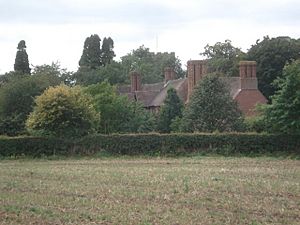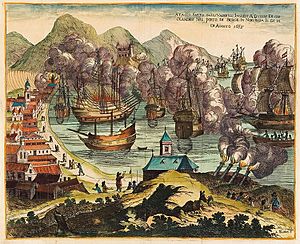Gilbert Talbot (courtier) facts for kids
Quick facts for kids
Sir
Gilbert Talbot
|
|
|---|---|

Talbot family home, Salwarpe Court
|
|
| Deputy Lieutenant, Wiltshire | |
| In office 1688–1689 |
|
| Monarch | James II |
| MP for Plymouth | |
| In office 1666–1679 |
|
| Monarch | Charles II |
| Preceded by | Samuel Trelawny † |
| Succeeded by | John Maynard |
| Special Envoy Denmark-Norway | |
| In office 1664–1666 |
|
| Monarch | Charles II |
| Master of the Jewel Office | |
| In office 1660–1690 |
|
| Envoy to the Republic of Venice | |
| In office 1637–1645 |
|
| Monarch | Charles I |
| Personal details | |
| Born | ca 1606 Salwarpe, Worcestershire |
| Died | 15 December 1695 (aged 89) Lacock Abbey, Wiltshire |
| Resting place | St Michael's, Salwarpe |
| Nationality | English |
| Parents | Sharington Talbot (1577–1642) Elizabeth Leighton (1580–1631) |
| Alma mater | Christ Church, Oxford Lincoln College, Oxford |
| Occupation | Diplomat |
Sir Gilbert Talbot (around 1606–1695) was an important English diplomat. He worked in the Republic of Venice from 1634 to 1645. Later, he was an envoy to Denmark-Norway from 1664 to 1666. He also served as a Member of Parliament for Plymouth from 1666 to 1679.
During the First English Civil War (1642–1646), he tried to get financial help for King Charles I from Venice. He returned to England in January 1645 and was knighted. He stayed out of the Second English Civil War in 1648. However, he was arrested in 1650 for supposedly planning to bring back Charles II. After he was released, he joined Charles II, who was living in exile.
When the monarchy was restored in 1660, he became the Master of the Jewel Office. He also served as a special envoy to Denmark during the Second Anglo-Dutch War (1664–1667). Sir Gilbert was always very loyal to the Stuart kings. In 1688, King James II made him a Deputy Lieutenant of Wiltshire.
After the Glorious Revolution in November 1688, he refused to support the new rulers, Queen Mary II and King William III. Because of this, he lost his jobs. He never got married and passed away on July 23, 1695.
Early Life and Education
Gilbert Talbot was born in 1606. He was the younger son of Sharington Talbot (1577–1642) and his first wife, Elizabeth Leighton (1580–1631). His family was related to the Talbot Earls of Shrewsbury. They originally came from Salwarpe, Worcestershire. His grandmother, Olive, brought Lacock Abbey, Wiltshire, into the family. The Talbots were known for living long lives. For example, Olive lived to be 97. Both Gilbert and his older brother Sharington (1591-1677) lived into their 80s.
Gilbert also had four half-brothers from his father's second marriage. One of them, Edward, was killed during the First English Civil War.
He went to Christ Church, Oxford, and earned a Bachelor of Arts degree in 1626. Then he studied at Lincoln College, Oxford, where he received a Master of Arts degree in 1628. He was also a fellow at All Souls College, Oxford, from 1629 to 1634.
Diplomatic Career
In 1634, Gilbert Talbot joined the English diplomatic team in the Republic of Venice. He worked there as a Secretary, then a Resident, and finally as an Envoy. During the First English Civil War (1642–1646), he tried to convince the Venetians to send money to King Charles I. He also thought of ways to take control of Parliamentarian merchant ships. However, Venice did not want to get involved because London was important for their trade.
He came back to England in January 1645. He traveled to Oxford, which was King Charles's wartime capital. There, he was knighted. In early 1645, the King's supporters still controlled parts of England and Wales. Even though he had no military experience, Talbot was made governor of Tiverton Castle in Devon. His older brother, Colonel Sharington Talbot, was in charge of the King's forces at Lacock Abbey, Wiltshire.

The New Model Army, led by Sir Thomas Fairfax, won many battles. By mid-July, the King's side was losing. Tiverton Castle fell on October 19. Talbot was captured but later exchanged. He went to Oxford, which surrendered in June 1646. This ended the First Civil War.
After the surrender, he was allowed to go home without having to pay a fine. He moved to Dartmouth and did not take part in the Second English Civil War in 1648. In 1650, he was arrested because people thought he was secretly planning to bring back Charles II. He was held in Gloucester prison.
After his release, he went abroad to join Charles II and his court in exile. He became a Gentleman Usher of the Privy Chamber. During this time, he joined a group that was against the Earl of Clarendon. This group was led by the Duke of Ormond. When the monarchy was restored in 1660, Ormond helped him get the job of Master of the Jewel House.
In September 1664, during the Second Anglo-Dutch War, he was sent as a special envoy to Denmark. He helped with secret talks between King Charles and King Frederick III. These talks were about attacking a Dutch merchant fleet that was hiding in the Norwegian port of Bergen. Even though Frederick was an ally of the Dutch, he agreed to tell his soldiers not to shoot at the English ships. In return, he would get a share of the money. However, the Danish soldiers did open fire, and Sir Thomas Teddeman had to retreat. Sir Gilbert was blamed for the confusion and was called back to England in April 1666.
When he returned, he was chosen to be a Member of Parliament for Plymouth in 1666.
Royal Society
Sir Gilbert Talbot was one of the first members of the Royal Society. This is a famous group that promotes science. When the Royal Society got its second official document in 1663, Talbot was chosen to be part of its governing Council. In 1667, he gave a presentation about "Swedish stone, which affords sulphur, vitriol, allum and minium."
Later Life
When Parliament was dissolved in 1678, he decided not to run for election again. He retired from active politics. Since he had always been loyal to the Stuart kings, King James II appointed him Deputy Lieutenant of Wiltshire in 1688. After the Glorious Revolution in November 1688, both he and his nephew Sir John Talbot refused to promise loyalty to the new rulers, Queen Mary II and King William III. Because of this, they both lost their positions.
In his later years, he lived at Lacock Abbey. He passed away there in 1695. He was later buried in his family's burial place at Salwarpe. He never married.
Images for kids


